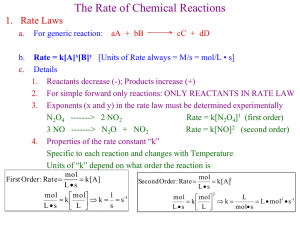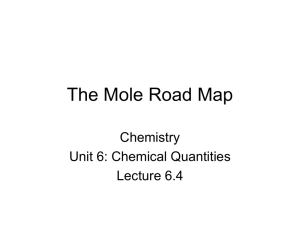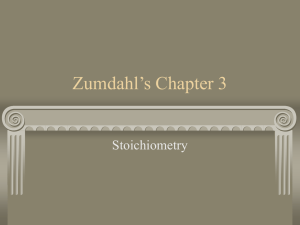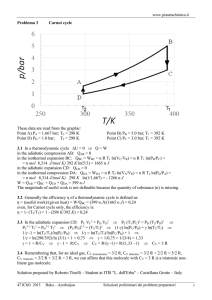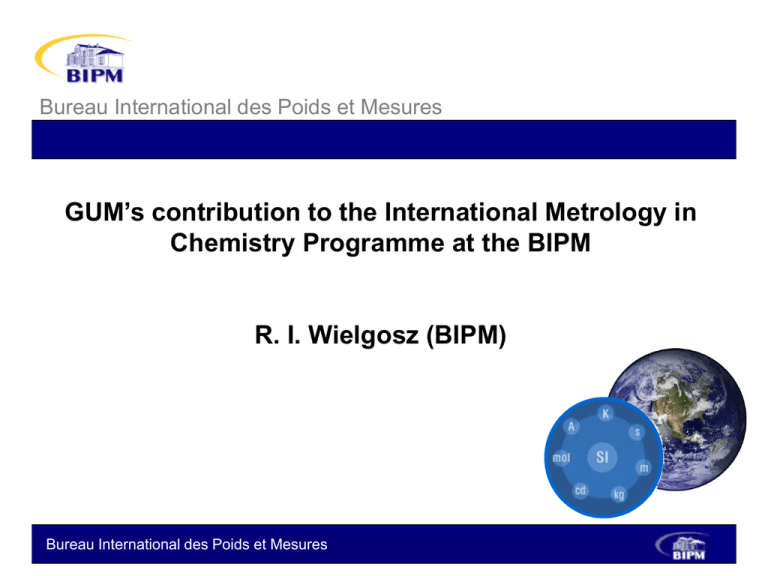
Bureau International des Poids et Mesures
GUM’s contribution to the International Metrology in
Chemistry Programme at the BIPM
R. I. Wielgosz (BIPM)
Bureau International des Poids et Mesures
1
OUTLINE OF PRESENTATION
• BIPM, International Metrology, National Metrology Institutes
• Visiting Scientist secondment programme to the BIPM
• Standards and comparisons for Atmospheric Composition: Air Quality and
Greenhouse Gases
• Conclusions and future outlook
Bureau International des Poids et Mesures
BUREAU INTERNATIONAL DES POIDS ET MESURES
The BIPM is an intergovernmental organization established by
the Metre Convention, through which Member States act
together on matters related to measurement science and
measurement standards.
www.bipm.org
The mission of the BIPM is to ensure and promote the global comparability of
measurements, including providing a coherent international system of units for:
• Scientific discovery and innovation,
• Industrial manufacturing and international trade,
• Sustaining the quality of life and the global environment.
BIPM Chemistry Department includes programme on:
International equivalence of gas standards for air quality and climate change monitoring
Coordinating comparisons of gas standards with the National Metrology Institutes and
Designated Institutes within the CCQM Gas Analysis Working Group
Bureau International des Poids et Mesures
Visiting Scientists to the BIPM Chemistry Department
J. Norris (NIST)
16 June – 1 Aug 2003
M. Sega (INRIM)
5 Sept – 2 Dec 2005
T. Ihara (NMIJ)
10 Oct – 10 Nov 2005
A. Rakowska (GUM) 31 Jan – 27 Apr 2006
Y. Shimitzu (NMIJ)
21 Aug – 15 Sept 2006
J. Guardado (CENAM) 30 March – 31 July 2007
C. Dazhou (NIM)
27 Aug- 20 Nov 2008
G. Ochmann (GUM)
1 Sept – 30 Nov 2008
C. Dazhou (NIM)
1 Oct – 4 Dec 2009
P. Mitchell (NMIA)
1 July - 30 Sept 2011
K. Tworek (GUM)
1 June – 30 Nov 2012
S. Lee (KRISS)
1 March – 31 May 2013
M. Lee (NIM)
1 May 2013 – 30 November 2015
C. Pascal (METAS)
1 March 2014 – 30 July 2015
D. Song (NIM)
1 June 2014 – 30 Nov 2014
M. Minarro (NPL)
1 Sept 2014 – 30 Nov 2014
B. Garrido (INMETRO) 1 Feb 2015 – 31 May 2015
Bureau International des Poids et Mesures
Greenhouse and Air Quality Gases
Air
Quality
Pollutant
Ozone
Sulphur dioxide (SO2)
Nitrogen dioxide (NO2)
Carbon monoxide (CO)
Benzene
Fine particles (PM2.5)
PM10
Lead (Pb)
Concentration
60 nmol/mol
120 nmol/mol
45 nmol/mol
100 nmol/mol
20 nmol/mol
8 µmol/mol
1.5 nmol/mol
25 µg/m3
50 µg/m3
40 µg/m3
0.5 µg/m3
Averaging
period
Maximum
daily 8 hour
mean
1 hour
24 hours
1 hour
1 year
Maximum
daily 8 hour
mean
1 year
1 year
24 hours
1 year
1 year
Greenhouse
Gases
GAS
Carbon dioxide (CO2)
Methane (CH4)
Nitrous oxide (N2O)
Tropospheric ozone (O3)
Halocarbons
Recent
tropospheric
concentration
392.6 µmol/mol
1874 nmol/mol
324 nmol/mol
34 nmol/mol
(0.003 to 0.5)
nmol/mol
WMO-BIPM Workshop
2010 WMO-BIPM workshop on
“Measurements Challenges for Global Observation
Systems for Climate Change Monitoring’’
Signature of CIPM-MRA by WMO
Wielgosz R., Calpini B., (Editors), Report on the WMO-BIPM workshop on Measurement
Challenges for Global Observation Systems for Climate Change Monitoring: Traceability,
Stability and Uncertainty, Rapport BIPM-2010/08, 100 pp
http://www.bipm.org/en/events/wmo-bipm_workshop/
Bureau International des Poids et Mesures
6
Establishing Traceability for Atmospheric Ozone Measurements
Atmospheric Ozone Measurements
(Total Column, Stratospheric)
Satellite based
measurement
systems
(Surface ozone)
Dobson and Brewer
Spectrophotometers
Gas Phase
titration
UV ozone
photometers
FTIR based
systems
Ozone Standard
Reference
Photometer
Absorption
cross section
(UV)
Absorption
cross section
(IR)
BAKI titration
Optical
measurements
of pure O3
Gravimetry
NO / NO2
Gas standards
Gravimetry
Iodide
standards
Pressure
Volume
Temperature
Surface Ozone Standards and Comparisons
BIPM-NIST programme to maintain the
comparability of the worldwide network of ozone
reference standards
-20
-15
NIES GPT
-10
BIPM GPT
UV Photometric Methods
CSIR-NML (2)
-5
IMGC
NMi-VSL
NILU
NERI
CSIR-NML(1)
CHMI
NIES
UBA (D)
NDENW
NPL
SP
UBA (A)
WMO/WCC-EMPA
FMI
VNIIM
LNE
15
KRISS
METAS SRP14
METAS SRP18
Environment Canada
ERLAP
ISCIII
NIST
Degree of equivalence (nmol/mol)
CCQM-P28 Degrees of Equivalence, Ozone mole fraction:420 nmol/mol
20
(k=2)
10
5
0
2.5% bias
relative to UV
method
GPT
Differences in Reference Methods for Ozone
Gas Phase Titration
NO + O3 NO2 + O2
Nitrogen Monoxide
Comparison
NO2 primary facility
(dynamic preparation)
CCQM-P73
CCQM-K74
NO (30-70) µmol/mol
(including validation of
spectroscopic methods)
3.000
0.20
2.000
1.000
NO2
0.15
-3.000
-4.000
-5.000
CCQM-P73 (LIMAS 11UV analysis)
CCQM-K1.c
EUROMET-K1.c
-6.000
NPL
NIST
NMi-VSL
BNM-LNE
KRISS
NRLM*
NRCCRM
VNIIM
OMH
BNM-LNE
NPL
VNIIM
NMi-VSL
GUM
CEM
METAS
CHMI
FMI
IPQ
-7.000
Laboratory (cylinder)
Absorbance
-2.000
KRISS (M1)
KRISS (M15)
CSIR-NML (M2)
CSIR-NML (M16)
CERI (M3)
CERI (M14)
VALCRM1 (M4)
VALCRM2 (M11)
VALCRM3 (M17)
LNE (M5)
LNE (M19)
SMU (M6)
SMU (M18)
CENAM (M7)
CENAM (M20)
VNIIM (M8)
VNIIM (M22)
NIST (M9)
NIST (M24)
NMIA (M10)
NMIA (M23)
IPQ (M12)
IPQ (M25)
NMi-VSL (M13)
NMi-VSL (M21)
D/ mmol/mol
0.000
-1.000
0.10
0.05
0.00
4000
3500
3000
2500
2000
Wavenumber / cm
Ozone reference
standard
comparison facility
Progress Report (2004-2005)
1500
-1
CCQM-P28
BIPM.QM-K1
Ozone (2-1000) nmol/mol
1000
Ozone cross-section a measurement challenge
Measure O2 and other impurities,
as O3 will never be “pure” (max ~99%)
Lopt to be measured by
interferometry
O3
ln( )
T
R
L opt 2( Pi PT ) N a
Consider ozone partial
pressure, as decomposition
2O3 -> 3O2 will rapidly occur
BIPM facility for ozone cross section measurements
Frequency doubled argon-ion laser
with intensity stabilisation
Large range
pressure
gauge
5 cm
absorption
cell
Mass
spectrometer
High accuracy
pressure gauge
(Baratron) for
P < 1 mbar
Ozone
generator
(high voltage
discharges)
Temperature
controlled
cryostat
Cryogenic Ozone Generator
• Double walls tube in glass
• Entire system inside temperature controlled
• Inside/outside electrodes to apply high voltage
• Discharges in oxygen produce ozone
cryostat
• Ozone trapped in liquid form
• Pumping to remove remaining oxygen
• Slow temperature increase release pure gas-phase
ozone
20 kV, 50 kHz
Liquid ozone trapped at 80 K
Absorption pathlength measurements by interferometry
Michelson interferometer to deduce Lopt in the cell in which the pressure is varied
Pressure in the cell: 1 bar -> 0.1 mbar
-> F fringes on the photodiode
-> Path length L0
n 1 L0
n
L0 / m
F
a / m
F
a
2
: index of refraction of air
: light path length
: number of fringes
: laser wavelength
Edlen formula for the air index of refraction at pressure P and temperature T
n 1
p 10
8
8342.54 2406147 (130 )
2
1
1
15998(38.9 ) 1 10
2
96095.43 1 0.003661T
8
0.601 0.00972 T
p
Absorption pathlength measurements by interferometry
Fringes signal on photodiode recorded with Labview:
Last series of measurements
5.01
Lopt = 4.978 cm with u(Lopt) = 0.012 cm
path length (cm)
5.00
Fringes are counted with Labview as well
=> most important uncertainty component
4.99
4.98
4.97
4.96
4.95
0
2
4
6
Measurement number
Typical values
Starting pressure Pi = 1012 hPa
Laser l = 632.991 nm
Temperature T = 22.39°C
F = 42.37 fringes
Giving Lopt = 4.978 cm, u(Lopt) = 0.012 cm
8
10
Absolute measurements of ozone cross-section with the UV-laser
1.0
-1
0.5
2
Cryogenic ozone generator
Evaporation-condensation cycles
Impurity analysis by RGA & FTIR
cm molecule
Accurate laser measurements of ozone absorption
cross-sections in the Hartley band
This work
Gorshelev
BDM
Burrows
(bogumil) / 10
-18
0.0
Ozone purity better than 99%
-0.5
-1.0
1.000
245
250
255
260
/ nm
BIPM values in agreement with absolute
measurements (in pure ozone)
Lowest uncertainty : 0.6%
-1
x(O3) / (mol mol )
0.995
0.990
0.985
0.2
0.4
0.6
P (sample) / (mbar)
0.8
1.0
Liquid ozone
trapped at 80 K
Accurate laser measurements of ozone
absorption cross-sections in the Hartley band.
J. Viallon , S. Lee , P. Moussay, K. Tworek , M.
Petersen , R.I.Wielgosz
Submitted to Atmospheric Measurement
Techniques
NO2 standards and comparison (10ppm)
CCQM GAWG key comparison on NO2 and Spectroscopic Measurements
BIPM dynamic gas
standard facility for NO2
The Air Quality Strategy for England,
Scotland, Wales and Northern Ireland
Objectives (for 2020) for particulate
matter (PM10), nitrogen dioxide (NO2),
ozone (O3), and polycyclic aromatic
hydrocarbons (PAHs) are unlikely to be
achieved, without further measures
Bureau International des Poids et Mesures
BIPM facility for NO2 Standards
Flow Control System for Rubotherm
1. Zero air generator
2. Nitrogen Generator
3. Nitrogen Cylinders
4. molbloc (0-1000) mL/min
5. SAES Nitrogen purifier
6. Mass flow controller (0-100) mL/min
7.
Rubotherm System (dynamic gas mixtures)
8.Magnetic suspension balance
9.NO2 permeation tube
Flow Control System for NO2 Gas Standards
10.Mass flow controller (0-1000) mL/min
11.Multi position valve (16-ports)
Mass flow controller (0-1000) mL/min
Flow Control System for Rubotherm
8
6
5
P
Rubotherm System
9
4
7
2
V3
P
waste
1
3
P
P
11
V
V
10
waste
P
Flow Control System for NO2 Gas Standards
Purity and quantification of permeating gas: Analysis by FTIR
Infrared absorbance spectrum of a 150 μmol mol−1
NO2/N2 gas mixture generated using the small
NO2 permeation device
0.20
0.18
Absorbance /Abs
0.16
0.14
0.10
0.08
Quantification of
HNO3 without gas
standards?
HNO3
0.12
NO2
H2O
HNO3
H2O
N2O4 negligible
impurity at lower
concentrations
0.06
0.04
N2O4
0.02
0.00
2000
1800
1600
1400
Wavenumber /cm
Bureau International des Poids et Mesures
1200
-1
1000
NO2 Permeation Rate and Impurities
Mass of Permeation tube
17.9
17.89
•Resolution: 2 μg;
•Stability,3 days: ~ 0.5 μg;
17.88
M HNO x HNO
3
3
M NO 2
17.87
mass/g
x NO 2
P V
m
q M
NO 2
v
17.86
NO2 permeation rate, P,
(5000-10000) ng/min
u 2 ng/min
17.85
17.84
17.83
xNO2 - NO2 mole fraction;
17.82
04/12/2007
12:00:00
05/12/2007
00:00:00
05/12/2007
12:00:00
06/12/2007
00:00:00
06/12/2007
12:00:00
P - NO2 permeation rate;
Vm - molar volume of nitrogen;
MNO2 - the molar mass of NO2;
07/12/2007
00:00:00
07/12/2007
12:00:00
08/12/2007
00:00:00
08/12/2007
12:00:00
09/12/2007
00:00:00
Time
FTIR gas
facility
qv - total flow of nitrogen;
MHNO3 - the molar mass of NO3; and
xHNO3 - HNO3 mole fraction measured by FTIR.
Flores E., Idrees F., Moussay P., Viallon J., Wielgosz R.,
Highly Accurate Nitrogen Dioxide (NO2) in Nitrogen
Standards Based on Permeation, Anal. Chem., 2012,
84(23), 10283-10290
Bureau International des Poids et Mesures
20
MALT calculation of HNO3 μmol/mol
HNO3 quantification using MALT
0.230
0.200
NO2
0.170
0.140
H2 O
0.110
0.080
0.050
8.0
9.0
10.0
11.0
12.0
13.0
BIPM_NO2 Facility XNO2 μmol/mol
6.45 m
HNO3
48.12 m
Uncertainty budget for the HNO3 for mole fractions of (0.1-0.2) µmol/mol
u ( x HNO 3 )
0 . 020 2 0 . 017 x HNO
Signal stability
Bureau International des Poids et Mesures
MALT-CLS
0 . 05 x
2
3
2
HNO
3
HITRAN database
21
Uncertainty budget for NO2 standards
x NO 2
Quantity
P V
m
q M
NO 2
v
Typical value
M HNO x HNO
3
3
M NO 2
Standard uncertainty
Relative
uncertainty
P
Vm
qv
MNO2
8.3573 μg min−1
22.4038 L mol−1
452 mL min−1
46.0055 g mol−1
4.18×10−3 μg min−1
0.34×10-3 L mol−1
0.455 mL min−1
1.40×10−3 g mol−1
5×10-4
1.52×10-5
1.00×10-3
3.04×10-5
xHNO3
0.104 μmol mol−1
0.021 μmol mol−1
2.02×10-1
MHNO3
xN2O4
63.013 g mol−1
0 nmol mol−1
1.17×10−3 g mol−1
0.866 nmol mol−1
1.86×10-5
N.A.
Quantity
xNO2
Value
8.86 μmol mol-1
Standard Uncertainty
0.03 μmol mol−1
Accurate FT-IR spectroscopy measurements of nitrogen dioxide (NO2) and nitric acid (HNO3) calibrated
with synthetic spectra, Edgar Flores*, Joële Viallon, Philippe Moussay and Robert Ian Wielgosz
(APPLIED SPECTROSCOPY 67 (10), 1171-1178, 2013)
Bureau International des Poids et Mesures
22
Results of international comparison for NO2 standards (CCQM-K74)
Value assignment of cylinders with BIPM NO2 facility (KCRV)
Flores E., et al. Final report on international comparison CCQM-K74: Nitrogen
dioxide, 10 µmol/mol, Metrologia, 2012, 49, Tech. Suppl., 08005
Transfer Gas
Standard NO2
mixture developed
by VSL
Amount of
substance
fraction~10
μmol/mol
Passivated
aluminum cylinders
of 5 L.
Bureau International des Poids et Mesures
23
Conclusions and Acknowledgments
• Strong collaboration and support of GUM through visiting scientists
highly valued
• Leads to innovation and improved international agreement of
standards at low levels of uncertainty
• Important for monitoring and decision making on Air Quality and
Greenhouse Gas Measurements
• Many thanks to GUM and Krzysztof Tworek, Grzegorz Ochmann and
Agata Rakowska
Future Outlook
• BIPM welcomes the support of GUM for its continued programme into
2016-2019, addressing:
• Carbon dioxide and Methane Standards (CCQM-K120)
• Formaldehyde Standards (CCQM-K90)
• Nitrogen Monoxide Standards
Bureau International des Poids
et Mesures
Bureau
International
des Poids et Mesures
24


